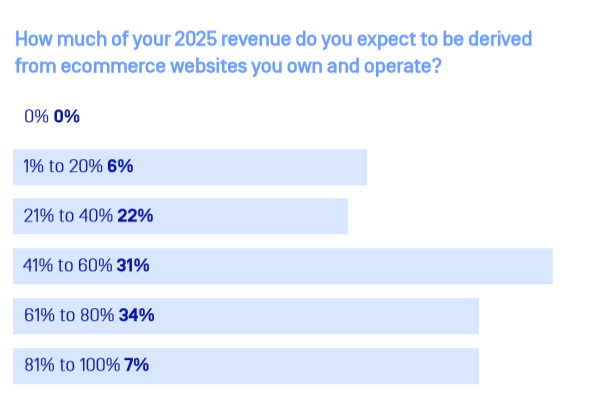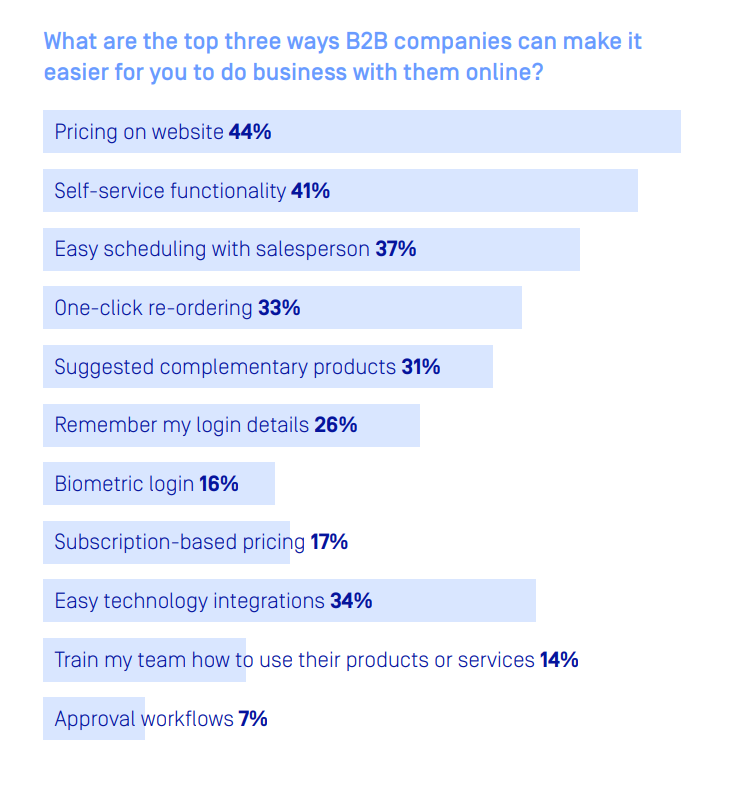Putting B2B processes online to meet digital experience expectations
In Episerver’s 2019 B2B Digital Experiences Report, they highlighted the top ways B2B companies can make it easier for their customers to do business with them online. The responses aren’t surprising but addressing some of these expectations can be challenging in the B2B space.

Lori McDonald

Existing business models and processes make the creation of digital experiences complicated. It is worthwhile to work through the challenges, as evidenced by the fact that 72% of the survey respondents in the B2B Digital Experiences Report said they believed the majority of B2B sales will be derived from the ecommerce websites they own and operate by 2025.

#1 - Pricing on the website for B2B sales
The top request seems like a simple enough expectation on the surface. For B2B organizations, pricing can quickly become a complex issue. It can be a struggle to share public information about your pricing for a variety of reasons. For example, you may have negotiated contracts with existing customers. While you want to protect your margins, you also want to gain new business. You are also likely used to evaluating pricing based on the overall value of the customer, so it can be a challenge to set pricing publicly.
In addition, pricing may not be easily available in your software systems. It may be managed by multiple systems or through processes that are not digitally accessible. If you do business globally, you may have currency conversions or different pricing rules for different markets.
As a B2B seller, you need to consider:
- How will your pricing rules work in the online space?
- How much of the process can be automated to determine the level of pricing new customers will receive?
- How will your existing customers create an online account for an ecommerce platform that will provide visibility into the pricing they already receive from you?
Episerver’s framework allows you to build a digital experience that will display pricing based on your business rules. Rather than limiting your options, the ecommerce platform provides an architecture for a great deal of flexibility to support unique pricing by markets, customers and dynamic promotions.
Working through your pricing rules, business processes and data architecture must be part of your B2B ecommerce development project in order to plan for an experience that will support your business value proposition and be the most straightforward for your team to maintain.

#2 – Self-service functionality
More and more, customers are expecting to be able to do things on their own, without having to talk to a person. B2B self-service can take many forms. Customers like the ability to reorder products on a B2B ecommerce platform with a single click (#4 on the list of ways B2Bs can make it easier to do business with them) and get product recommendations (#5 on the list). Think about how you experience Netflix or product recommendations on Amazon. We increasingly expect systems to be able to tell us what we need or recommend products we find relevant.
Since the B2B sales process can be complicated, self-service often isn’t as simple as picking a product and putting it in a shopping cart. It may be a guided selling processes that recommends the right product after answering a series of questions. You want to create a process that accomplishes the necessary steps while being as efficient as possible.
As you consider self-service functionality, start by systematizing the most common requests. Think about what inquiries your B2B sales teams and customer sales reps (CSRs) are fielding most frequently. How might you build a process that enables customers to serve themselves for the most common needs and requests? Then, you can expand over time.
While some digital platforms are built for a specific use case (e.g., a shopping cart), Episerver is a framework that can be extended to support a wide variety of use cases, incorporating ecommerce personalization based on machine-learning algorithms to make your customers’ lives easier.
#3 - Easy scheduling with a B2B salesperson
In the B2B world, it is still likely customers may need to interface with a salesperson for certain things. For existing customers, you can make their salesperson part of their customer portal when they are logged in by including contact information and even a picture to create a personal connection in the digital landscape.
For prospective customers, make sure there is a clear and easy entry point on your website. One of our customers using Episerver, Reico Kitchen and Bath, allows website visitors to book an appointment in their showroom. You can either have a form to ask visitors for a date and time that works for them or integrate with a variety of scheduling tools to book appointments directly on your salesperson’s calendar.
Take a systematic approach
All of the top online tools companies can use to meet customers’ growing digital expectations are tied to your systems. Setting up B2B websites and B2B ecommerce isn’t an off-the-shelf formula, as it varies for each business depending on your current business model and practices.
At Brilliance, we work with our customers to first learn how their business currently works. We ask a lot of questions so that we can learn:
- How does your B2B sales process work?
- What are your current systems and processes?
- How can we replicate those processes online?
Sometimes enabling the digital experience requires changes to your existing business processes. The good news is, done well, the changes result in overall process improvements for your business.
We recognize change can be challenging. As we help B2B companies leverage digital technology, we are often working with their teams to determine how best to approach the organizational changes required. Whether it’s pricing, ordering or communications, you will start by defining how it works today, and then looking at how it could work in a digital model that will meet evolving customer expectations tomorrow.
